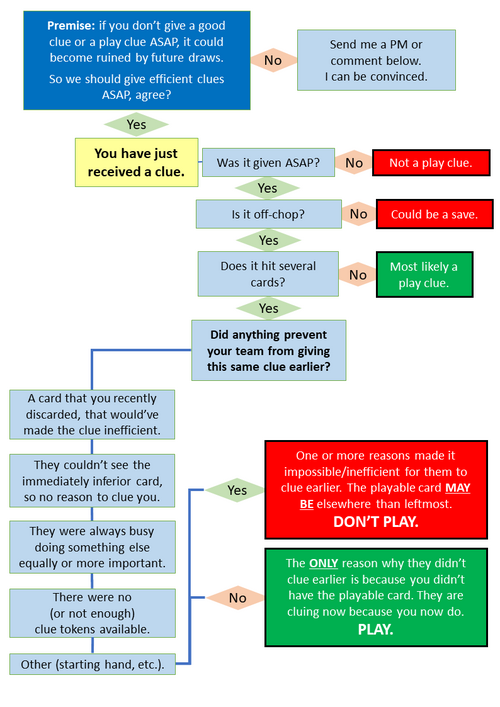-
Par berijeux le 5 Octobre 2019 à 00:46
1) Concrete LL examples
of when not to play on a multicard clue (and why)With visual setups and history logs.
So if you encounter such situations in your games, please bookmark them and send them to me. I might then screenshoot them and use them in the guide.2) A quizz
to test unknown players’ skills. From very basic to quite advanced LL.With visual setups and history logs.
Same request: any interesting situations, send them to me. votre commentaire
votre commentaire
-
Par berijeux le 14 Juin 2019 à 03:24
Click to enlarge.
Pay special attention to the red boxes: under usual conventions, you would play in these cases. In LL, you would not.
The end result is a less systematic, more analytic, more situational playstyle than what you may know, where you don’t always play leftmost.
Other LL links:
When NOT to play left
LL in a nutshell
Impacts of LL on strategy
Is LL inferior to CL? votre commentaire
votre commentaire
-
Par berijeux le 23 Mai 2019 à 18:26
Leftism (playing leftmost when several cards are clued) logically results from the following efficient principle:
one should clue playables as soon as possible (ASAP)
(otherwise the clue might be made worse by future draws)OK. Now, if you extend this logically:
1) A clue that is not given asap = not a play clue
2) IF the following conditions are met, [given asap] means [play left]
a- the clue is not on chop
b- the clued cards are not the same age (starting cards)
c- it is 100% true to say: “if the playable card were not the newest among them, they would have clued me earlier” (the “wait factor”)
Consequence: you can still "play left", but only if the situation logically allows.3) In any other context, [given asap] does NOT mean [play left]
Because in many situations, it was not possible for your teammates to give the clue earlier, for a number of reasons (click me). In these cases, you cannot logically deduce where the playable card is and the clue should therefore not be considered an immediate play clue and you should NOT play leftmost.
Consequence: not all off-chop clues mean "play left", so you may sometimes safely clue cards that are in reverse order.The end result is a less systematic, more analytic, more situational playstyle than what you may know, where you don’t always play leftmost and may save more stuff quite safely.
**********
Other LL links:
When NOT to play left
LL think chart
Impacts of LL on strategy
Is LL inferior to CL? votre commentaire
votre commentaire
-
Par berijeux le 16 Février 2019 à 03:19
The first impression a CL player might have after playing LL is – it’s slower and therefore less efficient. Let’s look into the strengths and weaknesses of both styles.
Note that not all these points have the same "weight".
LL CL You can save unique cards safely
True, with either value or colour if context allows
True. Value is more appreciated. You can save non-unique cards safely True, with either value or colour if context allows It depends. Therefore more sensitive to buried second copies. Handles situations that the other style can’t handle
True
True Play per clue efficiency
(excluding finesses)
Less immediate plays.
Since you can save more easily, and saves will become plays in the longer term, play per clue ratio is not as obvious.
More immediate plays. Play per clue ratio seems more obvious, more easily observable.
Safety Safer playstyle. Allows many clues – on chop or off-chop – that would cause bombs in CL.
This way you can save cards that are neither critical saves, nor immediately playable.
More importantly, cluing a group of cards in reverse order is situationally allowed.
More aggressive playstyle. Since saving tolerance is lower than in LL, more clues would be interpreted as plays, regardless of context. Therefore higher risk of bombing with “original” save clues. Pace Lower % of clues that cause an immediate play.
May cause pace issues.
Higher % of clues that cause an immediate play.
Solves some pace issues.
Finesses Used very situationally – when the clue otherwise makes no sense and/or when the next player really is going to play because they have no way of knowing they shouldn’t.
Arguably better for safety and worse for pace.
Extensively used.
Difficulty Situation and history are far more important. Requires deeper analysis.
Therefore harder to master.
Much easier to teach to beginners. They can reach decent scores very quickly. Overall More freedom in clue-giving.
More mid-term / long-term planning.
"Good engine, great brakes."
More immediate speed.
"Awesome engine, poor brakes."
Other LL links:
LL in a nutshell
LL vs CL: the differences
When NOT to play left
LL think chart votre commentaire
votre commentaire
-
Par berijeux le 25 Avril 2018 à 10:41
Variant
When the following cards are successfully played, the subsequent effect applies.
m1: the team loses a clue*
m2: for the next three moves, no cluing
m3: for the next three moves, no discarding
m4: for the next three moves, no playing**
m5: the team loses a life or the game ends
*on BGA, you need to remember that you have one less clue token for the rest of the game, unless m1 was played when there were no tokens left
**if m2-m3-m4 are played consecutively, the next player can do nothing on their turn and the team loses
 votre commentaire
votre commentaire Suivre le flux RSS des articles de cette rubrique
Suivre le flux RSS des articles de cette rubrique Suivre le flux RSS des commentaires de cette rubrique
Suivre le flux RSS des commentaires de cette rubrique





